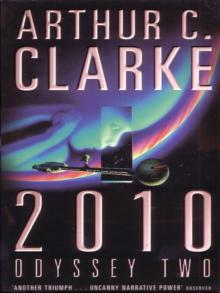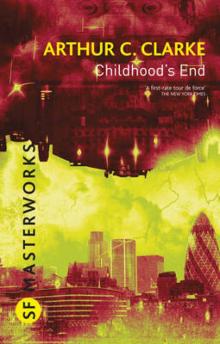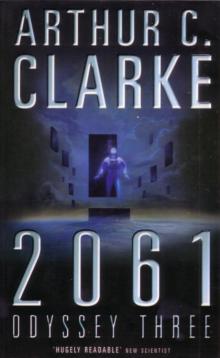- Home
- Arthur C. Clarke
Glide Path (Arthur C. Clarke Collection) Page 5
Glide Path (Arthur C. Clarke Collection) Read online
Page 5
The arrival of Dr. Hatton in T6 cut short these musings. It was the first time that Alan had seen the scientist looking really cheerful, and he guessed the reason.
“They’ve fixed it?” he asked hopefully.
Hatton nodded.
“Looks like it, touch wood. They’re just getting ready to roll out of the hangar, so I came to collect you.”
He caught sight of the newcomers, then added: “They’ve timed their arrival nicely. Maybe our luck’s changing.”
“We still don’t know,” complained Sgt. McGregor, “what we’re supposed to be doing here.”
“Jump in the truck,” said Alan. “This is the quickest way to find out. You, too, girls,” he added courteously.
The WAAFs took one look into the gloomy interior, at the oil-stained fuel drums that served as seats, and declined the invitation.
“No thank you, sir,” they said with one voice. “If it’s only round the airfield, we’ll follow on our bikes.”
Alan could hardly blame them; he was still trying to remove diesel oil from his own battle dress. But he wished he knew how they’d managed to get hold of bikes so quickly; he’d been trying ever since he arrived…
T6 arrived at the hangar just as the monstrous metal doors creaked apart on their steel rollers. They moved with understandable reluctance, for it was a full week since they had last opened; then the transmitter truck, followed by the smaller control van, drove out into the pale sunlight of the winter morning.
Alan had never before seen them in the open; he had to admit that they did not form a very handsome couple. With its cylindrical pillbox perched on the roof, protruding bay window, and square chimney, the transmitter truck looked rather like some kind of siege engine, built to storm a medieval castle.
“By the way,” Alan asked Deveraux, “why do the Yanks call that antenna housing a ‘Chick Sale’?”
“I haven’t a clue,” answered Deveraux, whose reading had not extended to The Specialist. “It seems some kind of private joke; probably Chick Sale’s one of their folklore heroes, like—er—Buffalo Bill or Rip van Winkle.”
The control van rolled to a halt beside them, and Pat Connor leaned out of the cab. He was unshaven but cheerful.
“And so we say farewell,” he intoned, “to glamorous Hangar F, scene of strange native orgies and primitive fertility rites, while the sun sinks slowly in the east—doing it the hard way.”
“We shall sink slowly in the east,” said Hatton, “unless you’ve got the bugs out of the system. I’ve checked with Flying Control; we can use Runway 270. As soon as we’re ready, they’ll send up an Anson to do approaches and overshoots. So let’s go.”
The RAF’s way of labeling runways was one of the dozens of new concepts that Alan had had to absorb at St. Erryn. It was simple and obvious, once one got used to it. Every runway was known by its compass heading, and therefore had two numbers, according to the direction of approach. Runway 270 thus pointed due west—and 090 was the same runway, looking east.
When the convoy arrived at the site, after trundling around more than a mile of perimeter track, Howard Rawlings gave a neat display of precision driving. Leaning out of the cab, he inched the huge transmitter truck back and forth until it was exactly aligned with some yellow survey marks already painted on the concrete.
“I laid those out with a theodolite a couple of weeks ago,” explained Hatton. “One thing about this job—you never know what you’ll have to try your hand at next.”
With a great wheezing and snorting of hydraulic jacks, the truck was then leveled. As it heaved this way and that, inching itself higher and higher off the ground, it looked rather like an elephant getting to its feet. But at last it was properly positioned, so that the radar antennas were aimed along the runway, pointing in the direction from which an aircraft would approach.
While all this was going on, Alan stood well back and observed the proceedings. Everyone knew exactly what to do; it was like watching an orchestra going full steam ahead without a conductor. Pat Connor was starting the big Caterpillar Diesel in the transmitter truck; it gave several annoyed coughs and then broke into a full-throated roar. Benny Schwartz and Dr. Hatton were unreeling the thick cables that linked the two trucks, and plugging them into their sockets; as they dragged them across the concrete, they looked like firemen wrestling with recalcitrant hoses.
When Alan followed Hatton and Deveraux into the control van, power was already on and green bars of light glowed across the faces of the radar screens. But the bars were stationary, not yet painting their pictures—for the antennas with which they were linked had not yet started to sweep the sky.
Dr. Wendt was sitting on one of the operators’ stools, staring at the dozens of meters, lights, and oscilloscopes but taking no action about any of them. His eyes roamed from panel to panel, and his nose twitched occasionally as it strained for the acrid, telltale stink of burning insulation. The cigarette holder had risen to the horizontal, indicating cautious optimism.
Howard’s voice, relayed from the transmitter truck, boomed over the intercom speaker.
“Everything fine here. I’m starting the scan.”
“Go ahead,” answered Wendt, “we’re ready.”
On the radar screens, the lines began to move. Each left behind it a ghostly afterimage that slowly faded—so slowly that it had not vanished completely before the electronic brush, sweeping back and forth, had returned to re-create it. The whole cycle lasted about two seconds; it was as if a television set had been slowed down a hundredfold, so that one could see each separate line of the image being formed. At the moment, the glowing rectangles were empty—frames awaiting their pictures.
Suddenly, flecks of brightness mottled the blank faces of the radar screen. Howard was tuning the receivers; the first signals were coming in, as the questing beams searched heaven and earth. Fuzzy, softly glowing pictures, meaningless except to those who knew how to read their messages of life and death, were appearing as if by magic. And it was magic; though he had watched countless radar displays, Alan had not yet lost his sense of wonder. He was seeing the world around him by waves a hundred thousand times longer than visible light. The images were blurred, and it would take him some time to interpret them, but that was to be expected. The patterns it perceives mean nothing to a baby when it first opens its eyes.
“We’re getting some nice, juicy echoes,” said Wendt with satisfaction. He pointed to a cluster of four closely spaced blobs forming a tiny square near the center of one screen.
“See that bunch? Those are the towers of Filey Radar Station, about six miles from here.”
Old-fashioned stuff, thought Alan smugly; compared with this equipment, the great radar chain that guarded England against the Luftwaffe already seemed like one of Marconi’s first experiments, and its three-hundred-foot masts as obsolete as dinosaurs.
“What about our aircraft?” asked Deveraux. “Shall I tell Flying Control to get it airborne?”
“Yes,” answered Wendt. “Ask the pilot to make a visual approach from five miles, overshooting and going around again until we tell him to stop. We won’t attempt to control him; I just want to see that everything’s working OK.”
Deveraux passed these instructions over the radio; a few minutes later Alan heard a faint roar of motors as the twin-engined trainer swept past them and climbed into the sky.
Dr. Hatton glanced at his wrist watch.
“We should see him in about four minutes,” he said, “coming in from the left.”
They waited in expectant silence; then, just as Hatton had predicted, a moving fleck of light appeared at the extreme left of the radar map. With each sweep of the scan it edged in toward the center of the screen, leaving a curving comet tail behind it.
Now the creeping glowworm had straightened out, and was moving on a course that led directly toward the airfield. It seemed to Alan, as he watched the fluorescent rectangle hanging there in the semidarkness, that he was really looking down
upon the earth and the approaching aircraft from an enormous height. Every twist and turn was revealed in such detail that one could almost read the pilot’s mind; now he had realized that he was too far to the right, and the crawling blip had begun to edge back toward the invisible line of the runway.
Alan had met this type of azimuth or plan display before, though never one with such a degree of precision. But the elevation display was something quite new to him, for it showed a vertical cross section of space, from ground level up to a height of five thousand feet. Along the bottom of the screen the ground was clearly defined by a line of bright echoes, strung one behind the other like beads on a necklace. Above that was nothing—except in one spot, where the isolated blip of the approaching aircraft hung in space. Alan could see from its slowly fading afterglow that it was flying at a constant altitude, for its comet tail was parallel to the ground far beneath.
But presently it began to descend, dropping down toward the line of ground echoes as the pilot started his approach; on the azimuth display, he was maintaining his steady course toward the runway, deviating neither to the right nor to the left. Then, about a mile from the edge of the airfield, he began to pull out; the descending curve flattened into a line parallel to the ground, and not many seconds later the truck shook slightly as the Anson roared past overhead. At almost the same moment, the echo disappeared from both of the display screens as the aircraft shot into the blind area behind the radar scanners.
“Next time round, we’ll start tracking,” said Deveraux. “Bishop—bring in the WAAFs—I want them to see this.”
Alan collected the girls, who had now arrived on their bikes and were sitting patiently in the driving cab of T6, exchanging gossip about the radar stations they’d known.
“Sorry we haven’t had time to explain anything,” he said, “but you’ll soon get the hang of it.” When he ushered them into the control van, he found that the others were already seated side by side in the operating positions, waiting for the echo to make its next appearance. Deveraux was on the left, in front of the elevation display; Hatton was on the right, watching the azimuth display. Between them sat Dr. Wendt, watching everything. Alan parked a WAAF behind each of the three swivel seats, the style and arrangement of which always reminded him of the line-up at a milk bar.
When the echo appeared, five miles away, Dr. Wendt threw a switch and a thin, bright line appeared on the azimuth screen. He spun a handwheel, and the line chased after the moving echo until it caught up with it.
“He’s tracking the echo in range,” Alan explained to the WAAFs. “That line has to be kept right on the blip. You can move it backward or forward by turning that small brass knob.”
Deveraux and Hatton were also busily turning wheels, each controlling the position of a little needle of light with which he was trying to spear his echo. When all three operators were on target, then the echo was being properly tracked in range, elevation, and azimuth. Then, and only then, would the mechanical brain of the landing system “know” exactly where the aircraft was in space.
“This is where the answer comes out,” said Alan, as he led the girls to the controller’s panel at the other end of the truck. The three meters were no longer blank; they were now illuminated and their needles were moving across the scales. Range said three and a half miles; elevation said fifty feet above the glide path; azimuth said one hundred feet left. Even as they watched, both the azimuth and elevation needles crept slowly toward zero error, while range shortened to three miles.
The girls were obviously impressed, but they were no more impressed than Alan. He certainly had no intention of revealing that this was the very first time that he, too, had seen the equipment at work. It was one thing to study the circuits and to know, in theory, how all this mass of electronics functioned. Yet somehow no amount of study could match a few seconds of the real thing. It was uncanny to stand here and to see these pointers recording every movement of that distant aircraft—and to know that they could do so with equal ease by day or night, in clear weather or blinding fog.
One and a half miles, said the range meter; zero error, said the azimuth meter, confirming that the aircraft was right on the center line of the runway. But the elevation meter was rapidly climbing, as the pilot broke off his approach and started to overshoot. A few seconds later, there was that familiar roar from outside, and the lights on all the controller’s meters went out as the trackers lost their echo.
So it went on, all through the morning. For the pilot of the Anson, it was probably monotonous; indeed, toward the end he was obviously getting careless, and lining up on the runway in a somewhat perfunctory manner. His azimuth error swung wildly from left to right; but nobody minded, for it was excellent practice for the trackers. By lunchtime, everyone had tried his hand at the game, and Alan had discovered that it was not so easy as it looked. That shining blip on the screen moved quickly, and unless you were alert, it would escape from your electronic needle. Once, when Alan let his thoughts wander for a few seconds, he found that he was several hundred feet off—and then compounded his error by turning the tracking handwheel in the wrong direction as he started to pursue the evasive blip.
“Remarkable aircraft you British make,” said Pat Connor, who had been watching this performance. “That’s the first time I knew an Anson could fly a thousand feet in three seconds—sideways.”
“That’s nothing,” retorted Alan with spirit. “Just now it flew backward—when a certain American scientist was tracking.”
“Touché,” said Dr. Wendt. “Maybe we’d better leave it to the girls. They’ve only done a couple of runs, and they’re better than us already.”
That was almost true, but it was not particularly surprising. These WAAFs were highly trained operators who had spent hundreds of hours tracking echoes on every type of ground radar in the RAF. They could take this job in their stride.
That evening, after the trucks had been driven back to the hangar, there was a small celebration in the Mess. Everyone knew that their main task was just beginning, but at least the equipment was now functioning well. That deserved a few drinks, and a greatly relieved Dr. Hatton was only too glad to buy the first round. He had already sent off a signal to Group HQ, asking for a couple of Flying Control officers who could be trained in the talk-down technique.
The Mess anteroom, where the party took place, had given Alan his first glimpse of the real RAF—the world of operational aircrews. Here, at any time of the day, flying types of all ranks from wing commander to humble pilot officer might be found sprawled in the overstuffed chairs, hidden behind Punch or the Illustrated London News—or, more likely, studying the current exposure of “Jane” in the Daily Mirror’s celebrated comic strip.
Most of these aircrewmen, even many of the senior officers, seemed little older than Alan, yet almost all had two or three ribbon bands on their tunics and jackets. What sights had they seen, what experiences had they passed through, that he could never share? Alan regarded them with a good deal of admiration and some awe, as well as a growing envy; for that night at Bomber Command had planted a seed in his mind.
In theory, none of the station personnel was supposed to know what GCD was all about. In practice, everyone did, and Alan had grown a little tired of flying types coming up to him and saying, “When are you going to get that gadget of yours working, old man?” Until now his reply had been: “Sorry—I’m not allowed to talk about it.” That was still the only reply he was supposed to give; but tonight the general behavior of the GCD team spoke volumes.
The party was a well-behaved one; the time for a lavish celebration had not yet come. No one went around with scissors cutting off ties; no one poured beer into the grand piano or tried to leave footprints on the ceiling. Deveraux and Hatton astonished everybody by doing a sprightly Cossack dance; Pat (after checking that the Padre was out of earshot) recited the saga of the Good Ship Venus, and the exploits of its ingenious but single-minded crew. It was Benny Schwartz, however,
who stole the show.
He had a splendid voice (“How can I help it? My grandfathers and uncles, as far as the eye can reach, have all been cantors”), and his rendering of “Summertime” was completely professional. On this cold, dreary winter night, with the rain and fog now rolling in from the Atlantic, it expressed all the yearning of the heart for sun and warmth—and peace. When Benny had finished, there was that silence that is a greater tribute than any applause.
It was broken at last by a sound from outside. The deep-throated roar of an ascending bomber set the room vibrating, starting the beer mugs dancing on the glass-topped tables. Louder and louder grew the thunder of the engines as the outward-bound Liberator climbed off the runway, heading for its long and lonely mission over the Atlantic.
All around him, Alan suddenly realized, the Mess had become tense and expectant. He was merely listening to an aircraft taking off—but these men were hearing the departure of friends they might not see again.
In that moment, something happened to Alan. Until now—despite the object lessons that Deveraux and Hatton had been careful to give him on his arrival—this project had not really involved his emotions. It was fascinating, he enjoyed the company, and he was prepared to work until he dropped; but it was just another of the jobs that had to be done to win the war.
Perhaps the trouble had been that the war was too big to grasp. But now he was engaged on something that he could see as a whole—something whose aims were direct and obvious. And, moreover, something in which he could play a share that was not altogether insignificant.
The voice of the Liberator died away over Land’s End; it was a sound, Alan knew, that must hereafter haunt his nights and days. It symbolized his new life; in the years to come, whenever he recalled St. Erryn, he would remember with both brain and heart the reverberation of those steadfast engines making their way across the western seas.

 Time's Eye
Time's Eye The Sentinel
The Sentinel Prelude to Space
Prelude to Space Earthlight (Arthur C. Clarke Collection)
Earthlight (Arthur C. Clarke Collection) 2001: A Space Odyssey
2001: A Space Odyssey Against the Fall of Night
Against the Fall of Night Glide Path
Glide Path The Lost Worlds of 2001
The Lost Worlds of 2001 The Trigger
The Trigger Reach for Tomorrow
Reach for Tomorrow Islands in the Sky
Islands in the Sky The Songs of Distant Earth
The Songs of Distant Earth 2010: Odyssey Two
2010: Odyssey Two Childhood's End
Childhood's End 3001: The Final Odyssey
3001: The Final Odyssey The Fountains of Paradise
The Fountains of Paradise Rama: The Omnibus
Rama: The Omnibus The Hammer of God
The Hammer of God Beyond the Fall of Night
Beyond the Fall of Night Tales From Planet Earth
Tales From Planet Earth 2061: Odyssey Three
2061: Odyssey Three Tales From the White Hart
Tales From the White Hart The City and the Stars/The Sands of Mars
The City and the Stars/The Sands of Mars The Star
The Star Imperial Earth
Imperial Earth The Light of Other Days
The Light of Other Days Firstborn
Firstborn The Other Side of the Sky
The Other Side of the Sky Cradle
Cradle The Wind From the Sun
The Wind From the Sun The Ghost From the Grand Banks and the Deep Range
The Ghost From the Grand Banks and the Deep Range The Deep Range
The Deep Range Expedition to Earth
Expedition to Earth A Fall of Moondust
A Fall of Moondust Dolphin Island (Arthur C. Clarke Collection)
Dolphin Island (Arthur C. Clarke Collection) Richter 10
Richter 10 The City and the Stars
The City and the Stars Tales of Ten Worlds
Tales of Ten Worlds Dolphin Island
Dolphin Island Expedition to Earth (Arthur C. Clarke Collection: Short Stories)
Expedition to Earth (Arthur C. Clarke Collection: Short Stories) Sunstorm
Sunstorm Rendezvous with Rama
Rendezvous with Rama The Collected Stories of Arthur C. Clarke
The Collected Stories of Arthur C. Clarke Trouble with the Natives
Trouble with the Natives Rama Revealed r-4
Rama Revealed r-4 The Sixth Science Fiction Megapack
The Sixth Science Fiction Megapack Firstborn to-3
Firstborn to-3 The Ghost from the Grand Banks
The Ghost from the Grand Banks Into the Comet
Into the Comet The Fires Within
The Fires Within 2061: Odyssey 3
2061: Odyssey 3 The Ninth Science Fiction Megapack
The Ninth Science Fiction Megapack The Coast of Coral
The Coast of Coral The Ghost from the Grand Banks (Arthur C. Clarke Collection)
The Ghost from the Grand Banks (Arthur C. Clarke Collection) The Space Trilogy
The Space Trilogy A Meeting With Medusa
A Meeting With Medusa 2001: A Space Odyssey (Arthur C. Clarke Collection: The Odyssey)
2001: A Space Odyssey (Arthur C. Clarke Collection: The Odyssey) Islands in the Sky (Arthur C. Clarke Collection)
Islands in the Sky (Arthur C. Clarke Collection) Rama II r-2
Rama II r-2 Glide Path (Arthur C. Clarke Collection)
Glide Path (Arthur C. Clarke Collection) The Sixth Science Fiction Megapack: 25 Classic and Modern Science Fiction Stories
The Sixth Science Fiction Megapack: 25 Classic and Modern Science Fiction Stories Tales from the White Hart (Arthur C. Clarke Collection: Short Stories)
Tales from the White Hart (Arthur C. Clarke Collection: Short Stories) The Reluctant Orchid
The Reluctant Orchid